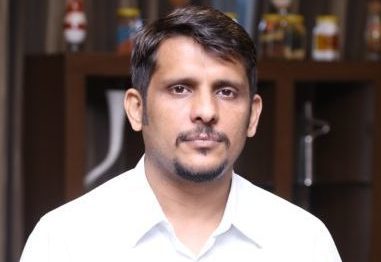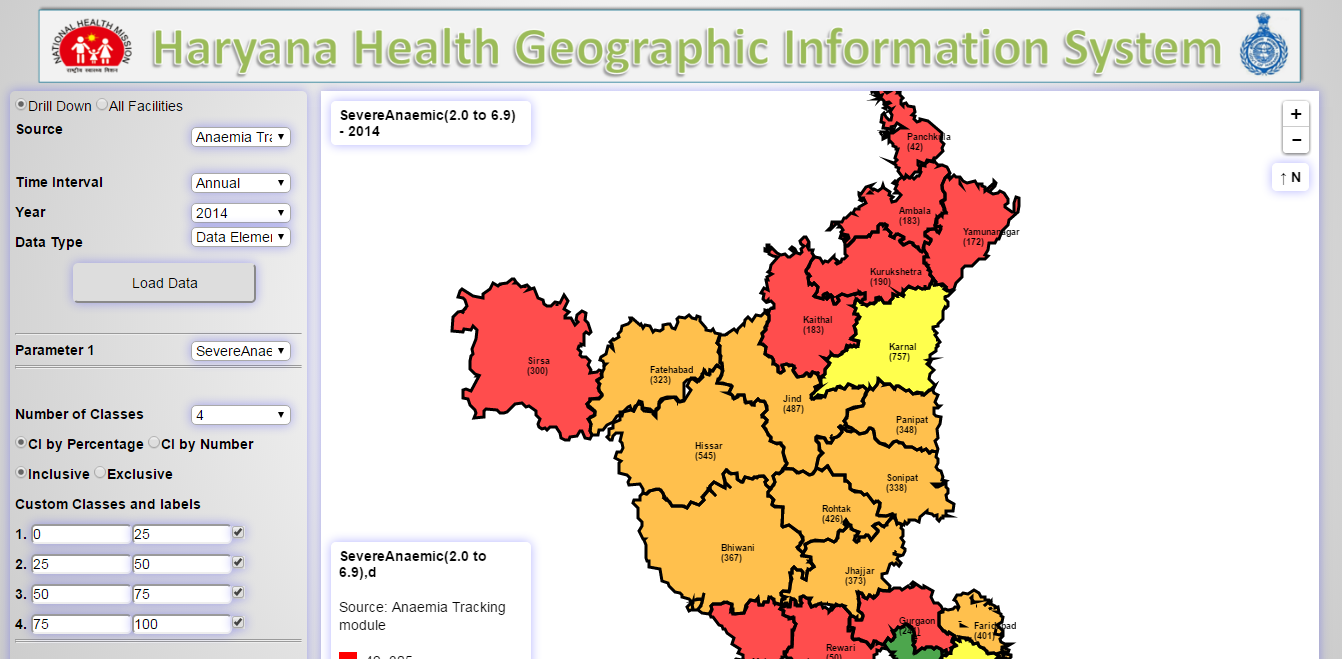Haryana Health Officials Praise New Geographic Information System
 Dr. Amit Phogat
Dr. Amit Phogat
Dr. Amit Phogat, Deputy Director at the National Health Mission, Haryana, India, recognizes the need to strengthen data use in public health decision-making. A trained medical doctor with a zest for technology and innovation, Dr. Phogat leads the Monitoring, Information Technology and Referral Transport programs.
He spoke with HFG about the steps the state has taken to increase data use in the health sector, including the development of the Haryana Health Geographic Information System (HHGIS).
Tell us about your role at the National Health Mission?
I joined the Haryana public health system in 2009. Now in my seventh year, I am managing programs in M&E, IT, and RT. Currently, I am looking after a diverse set of programs, from running mobile medical units and ambulances across the state to managing health information tools like the District Health Information System, Mother and Child Tracking System, and several other tools created specifically for the state of Haryana. Lately, we have been working with the HFG team to develop a geographic information system to improve data use.
What have been the main challenges to data use for public health decision-making in the state?
The state of Haryana has, over the years, developed several applications to capture more data from the field. We collected a huge amount of data, but ensuring that this data actually gets used to guide health programming remained a challenge. We have managed to make a huge quantity of data available in tables and charts, but that has failed to adequately engage the intended users—medical officers, program managers, and policymakers—who may not be trained for processing complex data tabulations. Lack of comfort with using computers and the Internet has also dampened enthusiasm for engaging with numbers.
Even in areas that appear to be doing well overall, there are poorly performing loci that were not being identified. This is problematic because in-depth exploration is crucial to understanding what’s not going well on the ground.
How were you working to tackle these challenges?
Haryana recognizes the need to ensure that public health decisions be based on real, hard data and evidence. Taking a comprehensive approach on the issue, the state has implemented many innovative solutions. Our recent focus has been on data visualization and interoperability, which we have achieved through the HHGIS application we developed with HFG’s support.
In fact, HFG has been working alongside NHM Haryana to power many of our efforts. The project has provided several new tools to support data quality and use, such as the real-time HHGIS application, the web-enabled Human Resource Information System, and the Routine Data Quality Assessment protocols. With HFG’s rigorous support, the state has succeeded in addressing data quality and use issues to a great extent.
Could you elaborate how you think the HHGIS software will change the way data are used?
In our experience, we have felt that presentation of data in dry, numeric formats like tables, charts, and graphs deters field-level staff and doctors, who may lack the statistical skills to understand and analyze the data. Visualization of data on colorful maps, on the other hand, makes data easily accessible to all in a quick snapshot.
The real-time visualization of data that HHGIS allows will help us break a major barrier to data use. Also, it pulls data from a plethora of existing health information applications onto one platform, making diverse data sets easily available for analysis. The application can create customized indicators and drill down to lowest facility level data for root-cause analysis. These are powerful features that will change how the program officers in the state analyze health data for programmatic decisions.
We are confident that this newly developed application will significantly lower barriers to data use. We have big plans for HHGIS. Going forward, we will add many more functionalities and make the application available on android devices.
What immediate changes in the state M&E team’s work do you expect?
HFG recently organized a hands-on training workshop on HHGIS for our M&E personnel and program managers. Based on the enthusiasm I witnessed at the training, I can say with a fair amount of certainty that the adoption of this application will be fast and wide. We will drive it further by making HHGIS part of the data use workshops we have planned for the coming months. In these workshops, we will train medical officers and program personnel on the use of different applications, enabling them to raise the right questions, use the data to find answers to those questions, and present the data. HFG support has been vital in strengthening evidence-based decision making in the state.
Ms. Babita
 Jind is one of the seven districts in Haryana, India, identified by the National Rural Health Mission as high-priority for improving child and maternal health outcomes. Recently released data from National Family Health Survey-4 show the proportion of young children fully immunized has declined and the proportion of anemic women age 15-49 years has significantly increased in Haryana.
Jind is one of the seven districts in Haryana, India, identified by the National Rural Health Mission as high-priority for improving child and maternal health outcomes. Recently released data from National Family Health Survey-4 show the proportion of young children fully immunized has declined and the proportion of anemic women age 15-49 years has significantly increased in Haryana.
The new Haryana Health Geographic Information System (HHGIS) application is an important step toward improving the quality of data and its use in Haryana. HHGIS is designed to dramatically enhance the analytical capabilities of the state’s M&E staff like Ms. Babita, the district M&E Officer for Jind. Use of data is imperative for making informed programmatic decisions about allocation of resources and strategies for strengthening delivery of priority health services and improving health indicators.
Ms. Babita and her counterparts from other Haryana districts were introduced to HHGIS at a recent training workshop. The hands-on training session was attended by 65 public health staff from the state, including district M&E officers and program officers. HFG spoke with Ms. Babita during the training.
What is your role at National Health Mission (NHM), Haryana, and how long have you been working in this capacity?
I have been working as Jind district’s M&E Officer (DMEO) for the last three years. Jind has a total of 209 public health facilities operating at different levels. My work involves monitoring the data reported by these facilities on health service delivery and events and providing feedback to health facility in-charges on the identified service delivery gaps.
Tell us how your role entails accessing and managing data from the different health information applications being used in Haryana.
It is my job to monitor the data from public health facilities in my district report for different national and state health programs. I work to ensure that the reported data is of high quality; that is, it is correct, complete, and timely. For this, I conduct regular checks on the reported data, identify any gaps, and get the errors corrected. Besides ensuring data quality, I also analyze the reported data to identify weaknesses in service delivery, for example, to facilities reporting high infant or maternal mortality. I report the findings to the program officers (deputy civil surgeons and senior medical officers) so that corrective action can be taken and health services improved.
Share with us the challenges you encounter in accessing and using data.
An important part of my job entails data comparisons, for which I need to check data from two different applications. This has proved to be a cumbersome process so far. For example, to study anemia in pregnant women, I would need to compare data from the Anemia Tracking Mechanism application and the District Health Information System application. Generation of different reports for data comparison is a tedious process, taking several hours or even days. Apart from being cumbersome, the process is also prone to clerical mistakes, which easily creep in when data is entered manually into tables for comparison.
Communication of findings and feedback presents its own challenges. I need to convey the findings to health facility in-charges to show them how their facility is faring and where the weaknesses lie. Even many program managers, who are medical doctors by training, find the data presented in tables and graphs too complex to understand and analyze. This adversely affects their awareness of issues on the ground and hampers decision making to initiate course correction.
Do you think the HHGIS will help you tackle these challenges?
For a monitoring person like me, HHGIS’s biggest benefit would be ease and speed of data access and analysis. The same task of data comparison that earlier took me several hours or even days will now be completed in a few clicks. The HHGIS application will allow me to immediately see comparative data on my computer screen. The HHGIS application will also help me in my job of ensuring data quality. Simply by looking at the screen for facilities with blank data reporting, I can quickly check data completeness and make out where no data or no services were provided. HHGIS enables data visualization as colorful maps, which are more user-friendly and accessible to even those not trained in statistical skills.
The same task of data comparison that earlier took me several hours or even days will now be completed in a few clicks.
What immediate changes do you expect in your work following this training?
I am quite excited about putting the application to use in my daily work. I monitor data for seven community health centers (CHCs). Apart from the saving of time and effort on data comparison, HHGIS will also enable me to undertake in-depth analysis with ease. The drill-down feature of the HHGIS tool will allow me to explore to the lowest facility level to identify which specific facility is reporting the weakest numbers and is in need of corrective action.
How do you think HHGIS will contribute to a stronger health system in Haryana?
I feel HHGIS will go a long way in improving data availability and use in the state. A few clicks reveal the required information in a visual snapshot. Even those who are not comfortable in using numbers and tables will be able to quickly see which health facilities are doing well and which need greater attention and resources.

A screenshot of Haryanas Health Geographic Information System.



